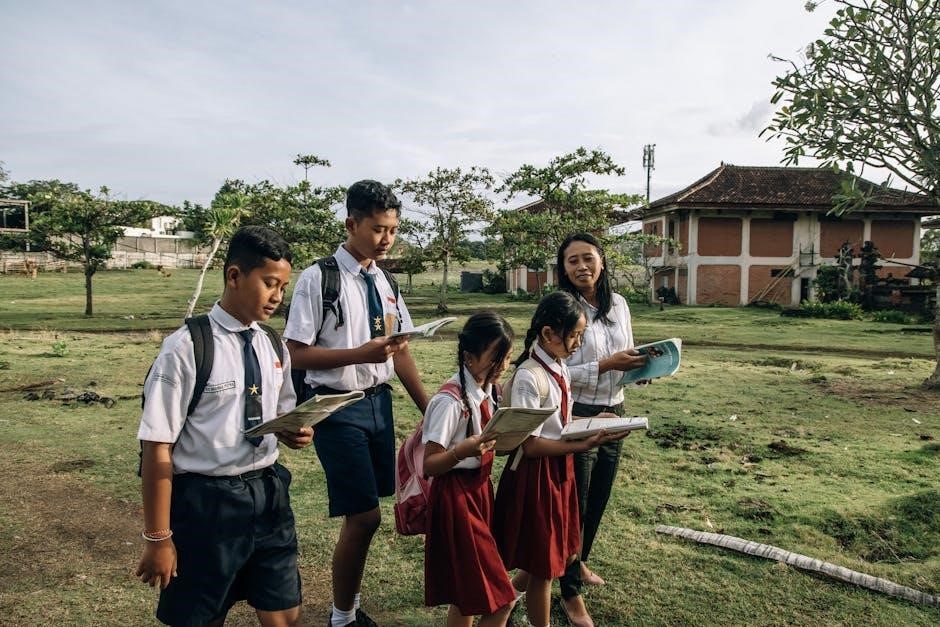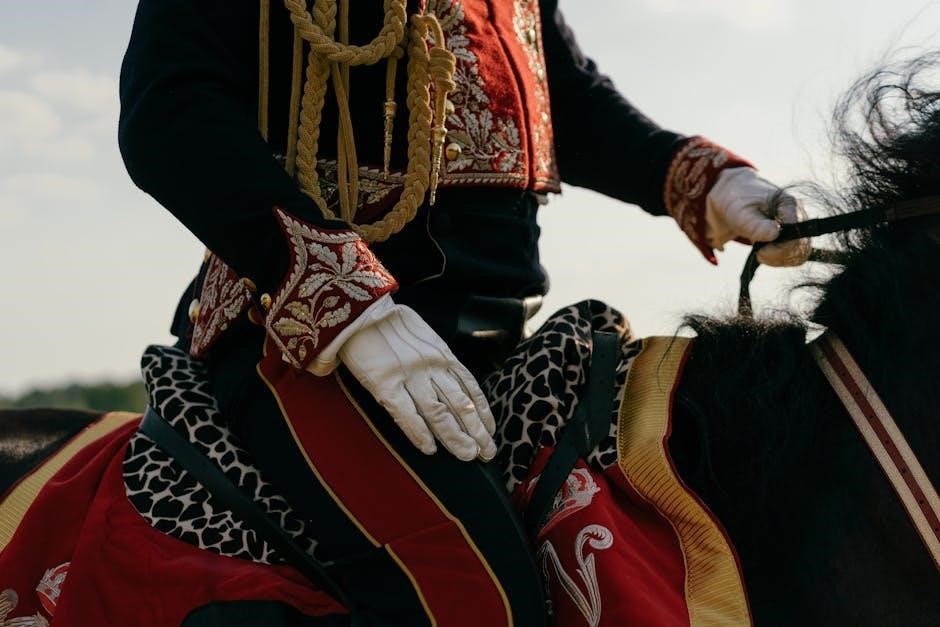This activity explores the interconnected histories of World War I and the Russian Revolution, fostering critical thinking and historical understanding through structured reading and discussion.

1.1 Overview of World War I and the Russian Revolution
World War I erupted in 1914, involving major global powers divided into alliances, while the Russian Revolution began in 1917, ending the Romanov dynasty. Russia, allied with Britain and France, fought against Germany and Austria-Hungary. The war drained Russia’s resources, leading to widespread discontent and economic collapse. This instability paved the way for the revolution, which culminated in the abdication of Tsar Nicholas II in March 1917. The Bolsheviks, led by Vladimir Lenin, seized power later that year, establishing the world’s first socialist state. Both events reshaped global politics, ending empires and inspiring new ideologies. Understanding their causes and consequences provides insight into modern history’s foundation.
1.2 Objectives of the Guided Reading Activity
The guided reading activity aims to deepen understanding of the causes, key events, and outcomes of World War I and the Russian Revolution. Participants will analyze primary sources, identify historical connections, and evaluate the global impact of these events. The activity encourages critical thinking, collaborative discussion, and the development of historical context. By exploring these pivotal moments, learners will gain insights into how political, social, and economic factors shaped the 20th century. The session also fosters effective communication skills through structured group discussions, ensuring active participation and a comprehensive grasp of the material.
World War I: Causes and Key Events
World War I was triggered by the assassination of Archduke Franz Ferdinand, fueled by complex alliances, imperialism, and militarism, leading to a global conflict with profound consequences.
2.1 The Assassination of Archduke Franz Ferdinand

On June 28, 1914, Archduke Franz Ferdinand, heir to the Austro-Hungarian throne, was assassinated in Sarajevo by Gavrilo Princip, a member of the Black Hand group. This event triggered a chain reaction of diplomatic crises and military mobilizations across Europe. Austria-Hungary, with Germany’s support, issued an ultimatum to Serbia, which led to Austria-Hungary declaring war on Serbia. Russia, bound by an alliance with Serbia, began mobilizing its military, prompting Germany to declare war on Russia. This escalation drew in more nations, including France and Britain, and marked the beginning of World War I. The assassination became the spark that ignited the broader tensions of imperialism, militarism, and nationalism, leading to one of the deadliest conflicts in history.
2.2 The Role of Imperialism and Militarism
Imperialism and militarism were central factors in the outbreak of World War I. European powers competed for colonies, resources, and global influence, creating tensions that fueled nationalism. Militarism, characterized by the buildup of armies and navies, heightened the likelihood of conflict. The complex system of alliances further escalated tensions, as nations prepared for war. The glorification of military power and the belief in the inevitability of war contributed to the aggressive policies of European leaders. These factors intertwined with the assassination of Archduke Franz Ferdinand, pushing the continent into a devastating conflict. The competition for dominance and the emphasis on military strength created an environment in which war became almost unavoidable, ultimately shaping the course of global history.

The Russian Revolution: Causes and Outcomes
Economic hardship, political unrest, and WWI’s strain led to the revolution, resulting in the Romanov dynasty’s collapse and the rise of a socialist state under Lenin.
3.1 The Fall of the Romanov Dynasty
The Romanov dynasty, which ruled Russia for over 300 years, collapsed during World War I due to economic hardship, political instability, and widespread discontent. Tsar Nicholas II, unable to manage the war effort and internal unrest, faced growing opposition. The provisional government assumed power after his abdication in March 1917, marking the end of the Romanov era. This collapse set the stage for radical political change, ultimately leading to the rise of the Bolsheviks and the establishment of a socialist state. The fall of the Romanovs remains a pivotal moment in Russian history, reflecting the consequences of war and internal strife.
3.2 The Rise of the Bolsheviks and Vladimir Lenin
The Bolsheviks, led by Vladimir Lenin, seized power in Russia during the October Revolution of 1917. Lenin, a charismatic and visionary leader, capitalized on the chaos and discontent following the fall of the Romanov dynasty. His promise of “peace, land, and bread” resonated with the war-weary population. After the provisional government’s collapse, the Bolsheviks established the world’s first socialist state, with Lenin at its helm. Lenin’s policies, such as land redistribution and the nationalization of industries, aimed to create a classless society. However, his rule also saw the suppression of opposition and the onset of a brutal civil war. Lenin’s leadership profoundly shaped the 20th century, leaving a lasting legacy in global politics and ideology.

The Connection Between World War I and the Russian Revolution
World War I drained Russia’s resources, causing economic hardship and discontent, which ultimately contributed to the Russian Revolution and the empire’s collapse.
4.1 How the War Weakened the Russian Empire
World War I significantly weakened the Russian Empire by draining its resources and exacerbating internal tensions. Russia’s economy struggled under the strain of wartime production, leading to food shortages and inflation. The military, unprepared for a prolonged conflict, suffered heavy casualties, eroding public morale. The war effort also highlighted the government’s inefficiency and lack of preparedness, fueling widespread discontent. Soldiers and civilians alike grew disillusioned with the monarchy, creating fertile ground for revolutionary ideas. The empire’s inability to recover from these challenges ultimately contributed to its collapse and paved the way for the Russian Revolution.
Guided Reading Activity Methods
This section outlines strategies for conducting effective guided reading sessions, fostering comprehension and critical thinking about World War I and the Russian Revolution.
5.1 Preparatory Steps for the Activity
Before starting the guided reading activity, several preparatory steps are essential. First, select relevant texts that cover key aspects of World War I and the Russian Revolution. Ensure materials are accessible and aligned with the students’ reading levels. Next, research and outline the historical context, including causes, key events, and outcomes. Prepare discussion questions to guide analysis and encourage critical thinking. Organize materials such as timelines, maps, and primary sources to supplement the readings. Finally, establish clear objectives for the activity, such as understanding the connection between the war and the revolution. These steps ensure a structured and engaging learning experience.
5.2 Strategies for Effective Group Discussion
To ensure productive group discussions, create a structured and inclusive environment. Assign roles such as facilitator, recorder, and timekeeper to promote accountability and organization. Encourage active listening and respectful dialogue to foster collaboration. Provide guiding questions tied to the reading material to focus conversations on key themes, such as the causes of World War I or the impact of the Russian Revolution. Incorporate primary sources like speeches or treaties to deepen analysis. Encourage students to connect historical events to broader themes, such as nationalism or political upheaval. Rotate roles periodically to ensure all voices are heard. Finally, allocate time for reflection and summarization, allowing groups to synthesize their findings and share insights with the class.
